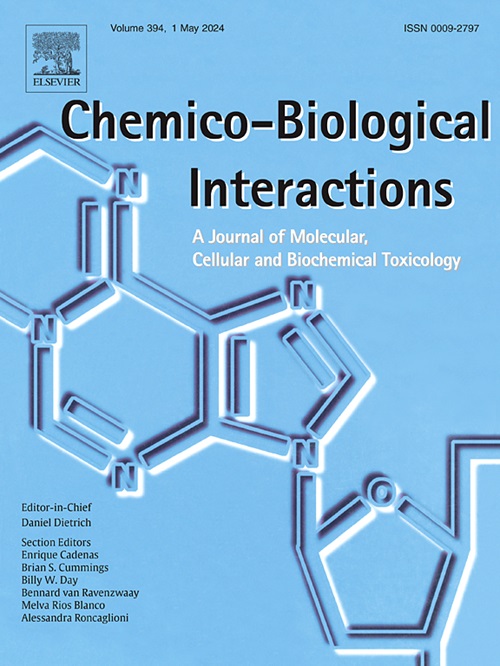RS194B oxime mediated AChE-reactivation and protection in lethal sarin and insecticide organophosphate exposed macaques is accompanied by oxime-independent BChE increases; likely a result of liver damage
IF 4.7
2区 医学
Q1 BIOCHEMISTRY & MOLECULAR BIOLOGY
引用次数: 0
Abstract
In both non-human primate and rodent models, the RS194B oxime is currently the most efficacious single administration post-exposure treatment against highly toxic organophosphate agents; rapidly reversing severe symptoms within 1–2 h and preventing death. This exceptional protective efficacy, which results from its ability to rapidly cross the BBB and remove the conjugated OP moiety from the active serine of OP-inhibited-AChE and BChE, allows for studies using severely OP-intoxicated macaques. We have compared here the reactivation of RBC-AChE and soluble BChE in the circulation to determine the relevance of each enzyme in survival; as an important aid in further oxime development. The results indicate that RS194B oxime administration to severely intoxicated macaques following exposure to inhaled sarin and paraoxon, and orally to diethyl-phosphorothioate insecticides, chlorpyrifos and parathion, results in very rapid AChE reactivation (>60 % in 1 h), sufficient by itself for protection, while the observed lower and slower increases in BChE activity play an insignificant role. Unexpectedly, increases in BChE activity appear to be biphasic in treated macaques, comprising an early oxime-dependent increase followed by a later increase observed after oxime has been eliminated from the blood; the latter increase also being observed in sarin-exposed and untreated animals. This previously unreported oxime-independent BChE recovery was observed in all OP-exposed macaques and is compatible with release/secretion of native BChE from stores in the liver as a result of OP-mediated damage; such increases being too fast to represent water-mediated reactivation or biosynthesis.
暴露于致死性沙林和有机磷杀虫剂的猕猴体内,RS194B肟介导的乙酰胆碱再激活和保护伴随着肟无关的BChE升高;可能是肝损伤的结果。
在非人类灵长类动物和啮齿类动物模型中,RS194B肟是目前针对高毒性有机磷制剂暴露后最有效的单次给药治疗;在1-2小时内迅速逆转严重症状,防止死亡。这种特殊的保护功效是由于它能够快速穿过血脑屏障,并从OP抑制的ache和BChE的活性丝氨酸中去除共轭的OP部分,从而允许使用严重OP中毒的猕猴进行研究。我们在这里比较了循环中红细胞乙酰胆碱酯酶和可溶性BChE的再激活,以确定每种酶在生存中的相关性;作为进一步发展肟的重要援助。结果表明,重度中毒猕猴在吸入沙林和对氧磷、口服二乙基硫磷杀虫剂、毒死蜱和对硫磷后,给予RS194B肟可使乙酰胆碱酯(AChE)在1小时内迅速活化(约60%),足以产生保护作用,而BChE活性的较低和较慢的升高作用不显著。出乎意料的是,在接受治疗的猕猴中,BChE活性的增加似乎是双相的,包括早期的肟依赖性增加,随后在肟从血液中消除后观察到的后来的增加;后者在接触沙林和未经治疗的动物中也观察到增加。这种以前未报道的肟非依赖性BChE恢复在所有暴露于op的猕猴中观察到,并且与由于op介导的损伤而从肝脏中储存的天然BChE释放/分泌相容;这种增长速度太快,不能代表水介导的再激活或生物合成。
本文章由计算机程序翻译,如有差异,请以英文原文为准。
求助全文
约1分钟内获得全文
求助全文
来源期刊
CiteScore
7.70
自引率
3.90%
发文量
410
审稿时长
36 days
期刊介绍:
Chemico-Biological Interactions publishes research reports and review articles that examine the molecular, cellular, and/or biochemical basis of toxicologically relevant outcomes. Special emphasis is placed on toxicological mechanisms associated with interactions between chemicals and biological systems. Outcomes may include all traditional endpoints caused by synthetic or naturally occurring chemicals, both in vivo and in vitro. Endpoints of interest include, but are not limited to carcinogenesis, mutagenesis, respiratory toxicology, neurotoxicology, reproductive and developmental toxicology, and immunotoxicology.

 求助内容:
求助内容: 应助结果提醒方式:
应助结果提醒方式:


